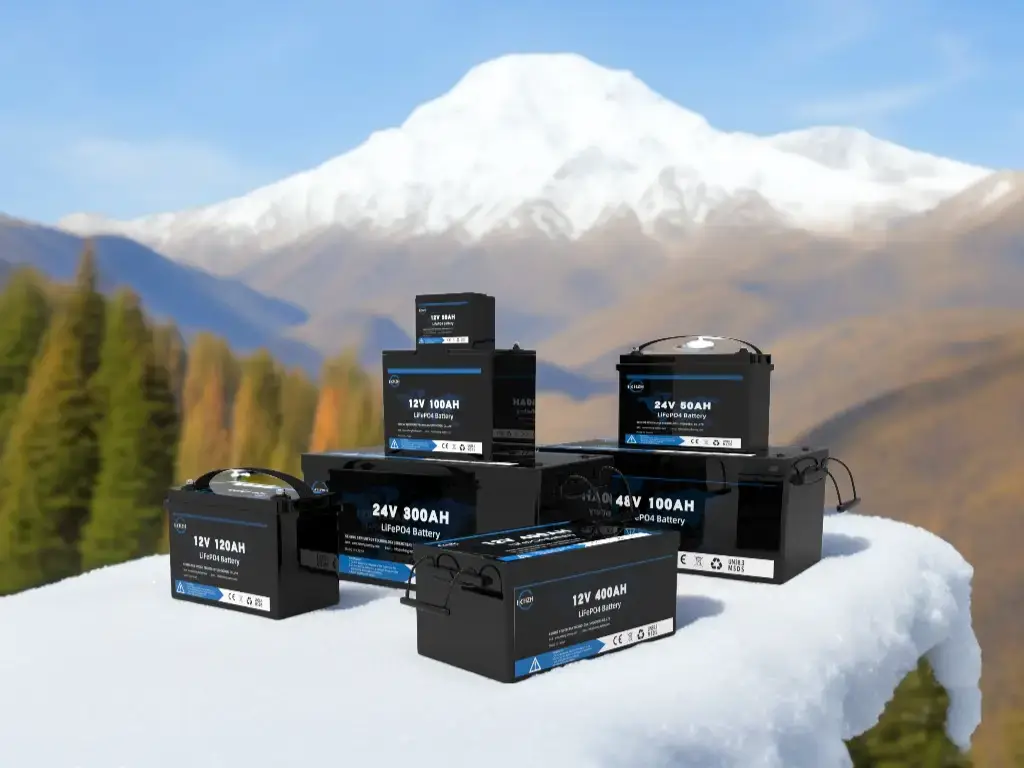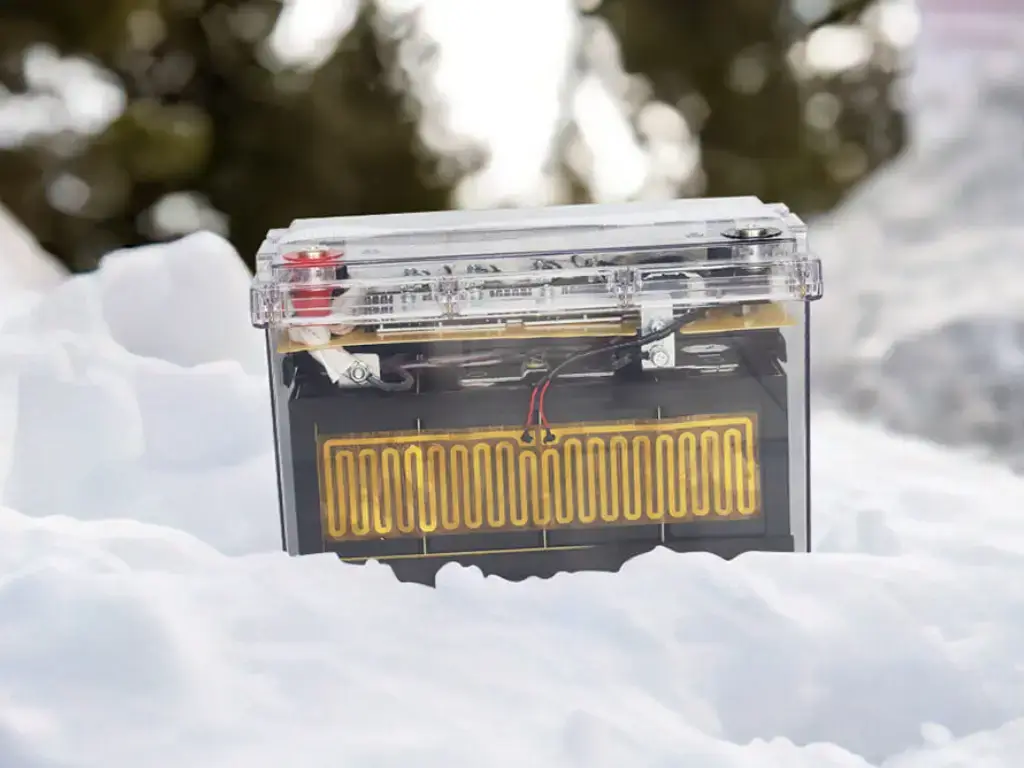RV solar panels help every RV camper provide free electricity and are highly sought after by many RV enthusiasts. For the novice RV enthusiast who is just getting started, we have provided you with this basic guide to getting started with solar panels for RVs. I hope that every RV investment and RV enthusiast can help!
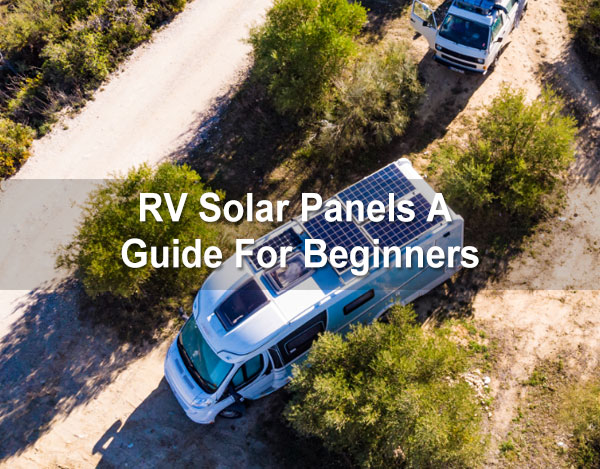
What are RV solar panels?
Solar panels (also called solar modules) are components assembled from multiple solar cells and are the most important core part of a solar power system.
RV solar panels power generation principle
Before understanding the power generation principle of RV solar panels, you need to know the principle of solar power generation
In 1839, the French scientist Alexandre Edmond Becquerel discovered that materials like metals emit electrical sparks when exposed to sunlight.This is what Einstein later named the photoelectric effect.The photoelectric effect occurs when electrons are ejected from the surface of solid materials such as metals when exposed to sunlight. Any material that reacts to this sunlight exposure is considered a light-emitting material, and the electrons that are ejected are called photoelectrons.

In fact, these sun-exposed electrons are no different than those flying around a circuit via a battery or direct power source. They are all doing the same job and remain the same in terms of mass, charge, spin and magnetic motion.
When the photon penetrates the photovoltaic cell, the photovoltaic cell transfers its energy to lose electrons, which are subsequently deorbited in the silicon atoms. At this point, the loose electrons look for the path of least resistance to the hole in the other atom, just like any other way of manipulating electrons.
As the electrons leave the solar cell in the form of electrical current, they enter the inverter through the conduit. The device converts currently regulated direct current (DC) to alternating current (AC), which can power homes, businesses, power plants and even the grid. Once our equipment and infrastructure are powered up, the current will flow back through the solar system’s electrical circuit, finding a break in the solid contact layer at the bottom of the solar panel, forming a closed loop.
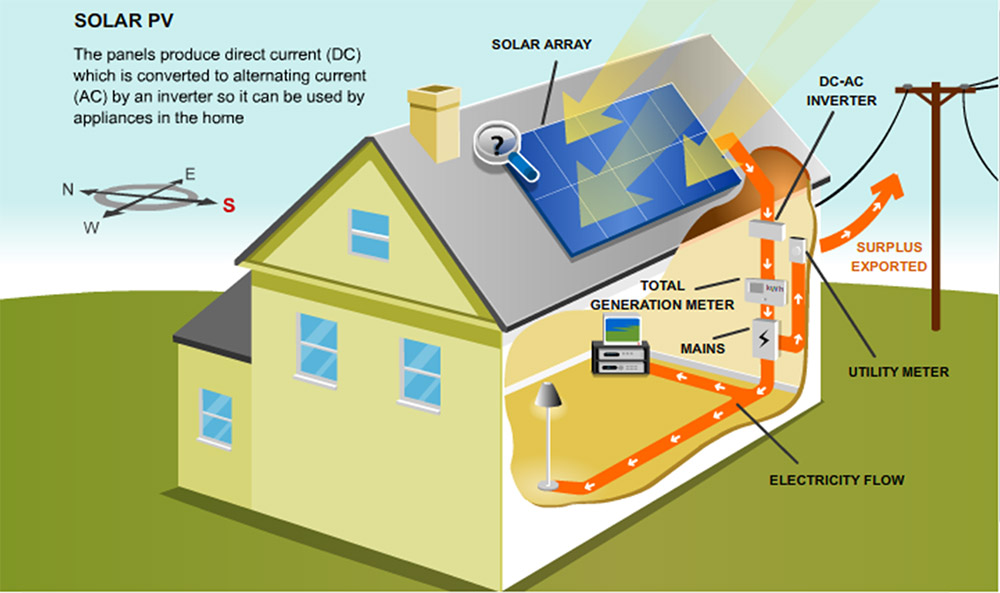
Solar power generation There are two ways of solar power generation, one is the light-heat-electric conversion method, and the other is the light-electric direct conversion method.
If you want to see the detailed principle of solar power generation, you can click here;How Solar Panels & Solar Electricity Works
RV Solar System Composition and Function
At present, crystalline silicon materials (including polycrystalline silicon and monocrystalline silicon) are the most important photovoltaic materials, with a market share of more than 90%, and will still be the mainstream material for solar cells for a long period of time in the future.
RV solar battery, also known as “solar chip” or “photovoltaic cell”, is an optoelectronic semiconductor sheet that uses sunlight to generate electricity directly. Single solar cells cannot be used directly as a power source. As a power source, several single solar cells must be connected in series or connected in parallel and tightly packaged into components.(buy solar battery)
RV solar panel composition and functions of each part
(1) Tempered glass: Its function is to protect the main body of power generation (such as cells ), and the selection of light transmission is required:The transmittance must be high (generally more than 91%);Ultra-white tempering treatment.
(2) EVA: It is used to bond and fix the tempered glass and the main body of power generation (cells). The quality of the transparent EVA material directly affects the life of the module.
The EVA exposed to the air is easy to age and turn yellow, thus affecting the light transmission of the module. In addition to the quality of EVA itself, the lamination process of module manufacturers is also very influential. For example, the adhesiveness of EVA is not up to standard, and the bonding strength of EVA to tempered glass and backplane is not enough, which will cause EVA Premature aging affects component life.
(3) Cells: The main function is to generate electricity. The mainstream in the power generation market is crystalline silicon solar cells and thin-film solar cells, both of which have their own advantages and disadvantages.
Crystal silicon solar cells have relatively low equipment cost, but high consumption and cell cost, but also high photoelectric conversion efficiency, which is more suitable for power generation in outdoor sunlight.
Thin-film solar cells have relatively high equipment costs, but low consumption and battery costs, but the photoelectric conversion efficiency is more than half that of crystalline silicon cells, but the low-light effect is very good, and it can also generate electricity under ordinary lights, such as calculators on the solar cell.
(4) Backplane: function, sealing, insulating, waterproof. Generally, TPT, TPE and other materials must be resistant to aging. Most component manufacturers have a 25-year warranty. Tempered glass and aluminum alloys are generally no problem. The key is whether the backplane and silicone can meet the requirements.
(5) Aluminum alloy: Protect the laminate and play a certain role in sealing and supporting.
(6) Junction box: It protects the entire power generation system and plays the role of a current transfer station. If the component is short-circuited, the junction box will automatically disconnect the short-circuit battery string to prevent the entire system from being burned. The most critical thing in the junction box is the selection of diodes. Different types of cells have different corresponding diodes.
(7) Silica gel: It is used to seal the components and the aluminum alloy frame, the junction of the components and the junction box. Some companies use double-sided tape and foam to replace the silica gel. And the cost is low.
RV Solar Panel Test Conditions
(1) Since the output power of the solar panel depends on factors such as solar irradiance and solar panel temperature, the measurement of the solar panel is carried out under standard conditions (STC), which is defined as: air quality AM1.5, light intensity 1000W /m2, temperature 25℃.
(2) Under this condition, the maximum power output by the solar panel is called the peak power. In many cases, the peak power of the module is usually measured by a solar simulator. The main factors that affect the output performance of solar panels are as follows:
1) Load impedance
Changes in load (resistance) cause module voltage changes, affecting panel efficiency and current output. Photovoltaic systems operate at voltages close to the maximum power point of the array. If the load resistance matches the module’s IV curve well, the module will operate at or near the maximum power point for maximum efficiency.
As the load resistance increases, the module will operate at a voltage higher than the maximum power point, resulting in a drop in efficiency and current output. Conversely, as the module voltage drops below the maximum power point, the efficiency of the module decreases.
2) Sunlight intensity
A Solar panel’s current output is proportional to the intensity of solar energy to which it is exposed. More intense sunlight will result in greater module output.
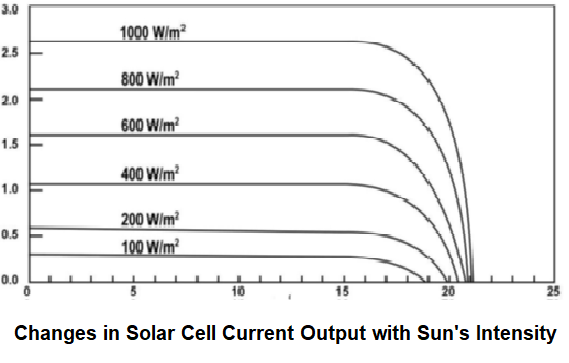
3) Temperature
Under the STC test conditions, where the standard battery operating temperature rises above 25 degrees Celsius, the shape of the IV curve remains the same, but it shifts to the left at higher battery temperatures, indicating lower voltage output. The voltage will also drop. Therefore, the operating efficiency and voltage of the solar cell panel at this time are lowered.
A good installation should allow air flow under and over the modules to remove heat to avoid high cell temperatures.
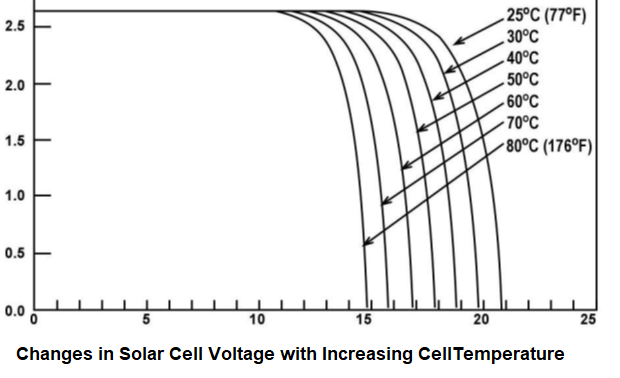
4) Shadows
Shading affects the output of a solar panel. Even partial shading of photovoltaic modules will result in a dramatic output reduction. Some modules are more affected by shading than others. The illustration below shows the extreme effect of shading on one cell of a crystalline cell module.
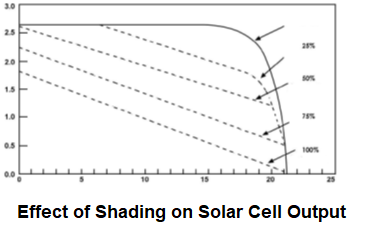
Locating shading obstacles at the site is an extremely important part of a site evaluation. An entire system’s performance can be diminished by underestimating the effects of shading, even partial shading. Some manufacturers make use of bypass diodes within the module to reduce the effect of shading by allowing current to bypass shaded cells.
RV Solar Panel Power Calculation
The solar AC power generation system is composed of solar panels, charge controllers, inverters and batteries; the solar DC power generation system does not include the inverter. In order to enable the solar power generation system to provide sufficient power for the load, it is necessary to reasonably select each component according to the power of the electrical appliance. Take 100W output power and use it for 6 hours a day as an example to introduce the calculation method:
1. First, calculate the watt-hour consumption per day (including the loss of the inverter): if the conversion efficiency of the inverter is 90%, then when the output power is 100W, the actual output power should be 100W/90 %=111W; if it is used for 5 hours a day, the power consumption is 111W*5 hours=555Wh.
2. Calculate the solar panel: According to the daily effective sunshine time of 6 hours, and considering the charging efficiency and the loss during the charging process, the output power of the solar panel should be 555Wh/6h/70%=130W. Among them, 70% is the actual power used by the solar panel during the charging process.
How much power solar panel do RV need
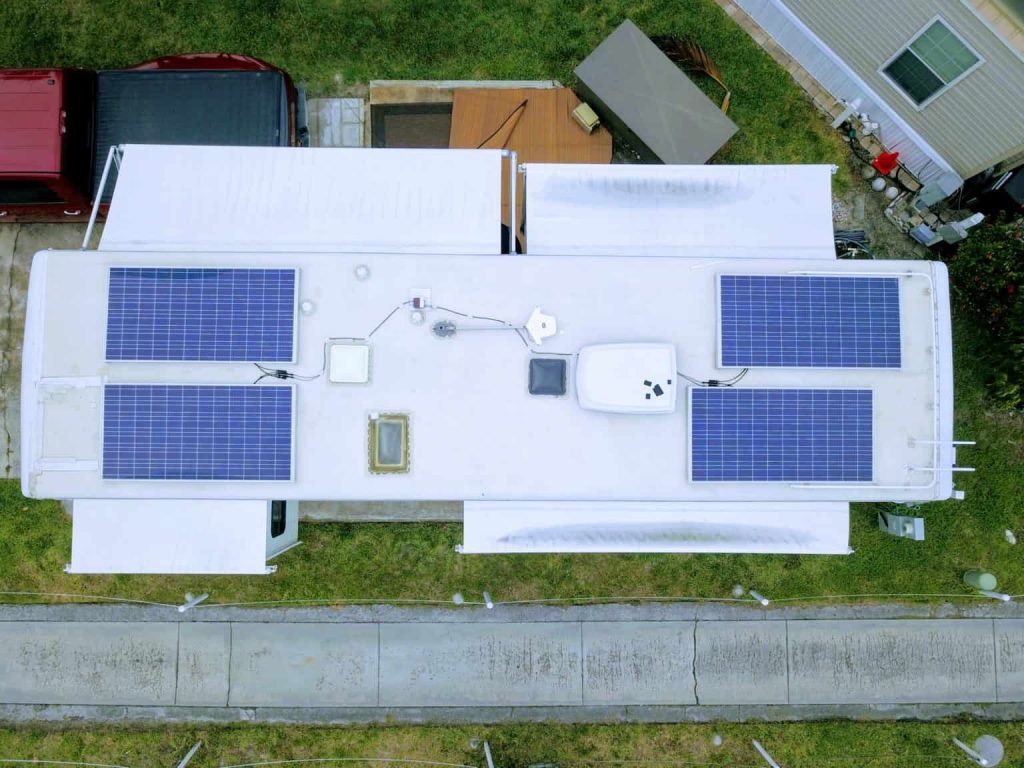
Many RV riders do not know how much power solar panels should be installed. In fact, this problem depends entirely on the actual situation of their own electricity consumption. The following list can cover most of the needs of electricity in the life of the RV. You can choose how much power solar panels to install according to the electrical equipment in the table.
Let’s take Lanzhong C7 RV as an example: the length of the body is 6 meters and the width is 2 meters, then the overall area of the roof is about 6 × 2 = 12 (square meters), excluding the area of the overhead forehead, the outdoor unit of the air conditioner, and the overhead sunroof , In addition to the space occupied by the satellite TV antenna, there is about 5 square meters of usable area on the roof of the RV. We have actually seen the optional solar cells on the factory roof of Lanzhong C7, which can install 6 solar panels without being blocked by other equipment. The power is within the range of 300W-400W. It can ensure the normal operation of lighting equipment and other small appliances in the car.
How RV Solar Cell System Works
RV uses solar energy mainly by absorbing sunlight through solar panels installed on the roof, and then converting it into AC power for daily use through inverters. The direct output voltage of solar energy is generally 12V, 24V, 48V. In order to provide electrical energy for 120V electrical appliances, it is necessary to convert the DC power generated by the solar power generation system into AC power through an inverter. In some occasions, when multiple voltage loads are required, DC-DC inverters are also used, such as converting 24V electrical energy into 5V electrical energy. The converted electric energy can be used directly or stored in a battery for emergency use.
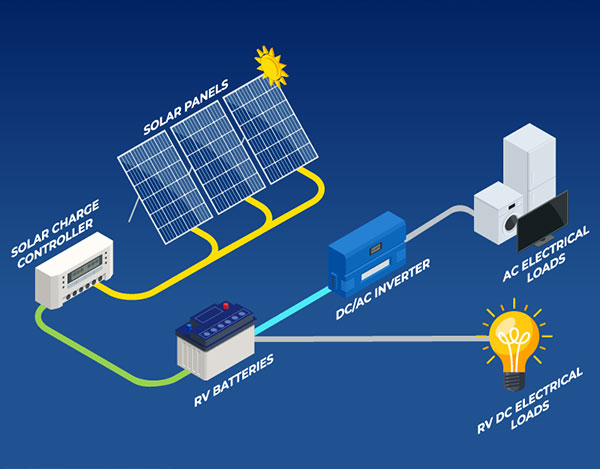
How much can an RV solar panel charge in a day
400 watt solar panel how many amps?
The maximum current of 400w solar is called Imp (maximum power current), and the supplier generally states it on the specification sheet.
Assuming a 400w solar panel, the maximum operating voltage (Vmp) is 42v, the voltage temperature coefficient is 49v, and its average current is 400w/42v=9.5 amps DC. Knowing the maximum amperage of a 400w solar panel can generally be read from the spec sheet.If converting to AC, deduct at least 10% of inverter losses. We should reduce the DC current value by the ratio of DC to AC voltage.
AC current = DC current x 42/120 (US local voltage) = 9.5 x o.35 = 3.325 amps AC
How much energy can a 400 watt solar panel produce?
Solar panel rating x irradiance (peak-sun-hours/day) = energy in watt-hours/day
Taking Las Vegas(5.701h) as an example, a 400 watt solar panel could produce:
400 watts x 5.701 = 2.28kWh/day = 832kWh/yearz
If a solar panel with a rated power of 400W-18v, in the case of standard light intensity and battery shortage, the theoretical storage capacity for 1 hour is 400W÷18V×12V×1h=0.267kW·h, which is what we often say 0.267 kWh, if calculated based on an average of 6 hours of light per day. Then 0.267kW·h×6=1.602kW·h, which is about 1.6 kWh. “
the best way to know the maximum amps a 400 watts solar panel can generate is to read the amps from the specification sheet
After calculation, we can see that, in theory, a set of 400W solar panels can generate 1.6 kWh of electricity a day. If the light intensity and the power loss in the middle are included, the charging efficiency is calculated at 70%, and the actual charging amount in one day It is 1.6×.0.7=1.12 kWh.
So what kind of electrical appliances can this 1.12 kWh of electricity bear for the normal operation? For a self-propelled C-type RV within 6 meters, the total RV lighting equipment is temporarily calculated at 100W, 80W refrigerator, 80W LCD TV, 30W notebook computer and mobile phone , the combined power is about 300W, which means that these electrical devices can work together for 1.6÷0.3=5.3 hours. Now everyone should understand, so many professional players will recommend that you choose solar energy between 300-400W.
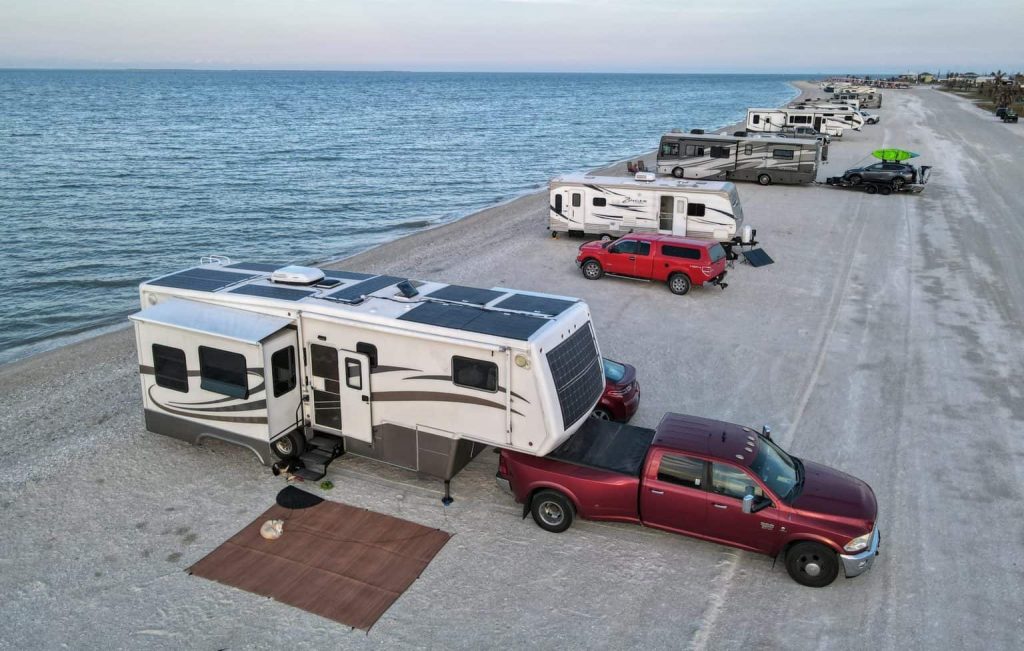
Composition of RV Solar Cell System
The solar system applied to the RV is not only a charging system, but also a small energy storage system. This system consists of solar photovoltaic modules, solar charge controllers and the batteries you need. The most common length of solar panels is about 1 meter 2, and the power ranges from 100W to 400W. This component is used to receive sunlight and is generally placed on the roof of the car.
RV Solar Charge Controller
In fact, it is a charging device. Now MPPT (the full name of MPPT controller is “Maximum Power Point Tracking”) solar controller is an upgraded product of traditional solar charge and discharge controller. The efficiency is much higher. , generally more than 95%. Now the small charge controller output that can be used in the car is automatically recognized, only the battery is 12V/24V/48V, if the battery pack voltage is 96V, 110V, 220V The corresponding charge controller needs to be selected. As long as the voltage of the solar cell module at the input end is not greater than the rated input voltage of the charge controller, it is ok. It is also necessary to note that the terminal voltage of the module must be higher than the battery voltage by more than 3-5V For example, if you are using a 12V battery, then the voltage of your components must be 17V or above to work normally. It is not a big problem if the component voltage is higher, as long as it meets the input voltage of the charge controller. .
RV battery
Generally, the size of the installed battery is selected according to individual needs. It is recommended to install a 400W solar panel on the RV to match a 200AH battery. Under the premise of sufficient light, the best state can charge the battery 60%-65%. The discharge of lead-acid batteries can generally be discharged to 25%-50%. What you may be more concerned about is whether the solar panel will be effective when the device consumes electricity while charging? Theoretically, there is no problem, but it should be noted that the power of the load and the power of the loss should be matched. For example, if the load power is 100W and the solar power is 200W, there will normally be 40%-50% loss (mismatch). loss), which can basically guarantee normal operation. If the load power is 100W, and the power of the solar panel is also 100W, then adding the normal loss, this cannot be guaranteed, and it needs to be balanced by the battery.
Dos and Don’ts of Installing Solar Panels in an RV
① Due to the unevenness of solar manufacturers, some panels will be equipped with metal frames, while others will be directly laid on the roof of the RV and then fixed. It is recommended that you choose solar panels with metal frames.
②Install the base. It can play the role of backflow air and also drain water. Because the speed of the vehicle is too fast during the driving process, the electric panel and the air generate pressure, which causes the electric panel to be lifted by the wind, causing danger.
③ Solar wiring harness. This is something to be aware of, it is very unprofessional if you use a car cable. Considering the aging problem of the wiring harness, it is necessary to use anti-aging photovoltaic wires. It should be noted that the photovoltaic wires and the solar power match.
④The choice of solar energy converter. The voltage of solar energy is greater than 12V, generally 24V and 48V. It needs to be matched to 12V or other power electrical equipment through the converter, and then the battery is charged through the converter.
⑤Choose the type of electric board. There are many types of solar panels on the market now, such as monocrystalline silicon panels, polycrystalline silicon panels, amorphous panels and photovoltaic flexible panels. The RV is currently equipped with monocrystalline silicon panels, because after actual experiments, the actual effects of monocrystalline silicon and polycrystalline silicon panels are similar, but the cost of polycrystalline silicon panels is high. Considering comprehensively, monocrystalline silicon panels are the most cost-effective.
The solar panels are at an angle to the plane of the RV roof
Maintenance and Care of RV Solar Panels
①For most users, the installation of solar panels is not done once and for all. If you often drive your RV to areas with severe haze or frequent sand and dust, remember to clean the surface of the solar panels frequently to prevent dust accumulation for a long time, resulting in Poor power generation efficiency.
②Maintenance of wiring harness. Regularly check to prevent the aging of the wiring harness, and generally replace the wiring harness at a frequency of 3-5 years.
③ The service life of the solar panel itself is generally more than 15 years, and the longer the time, the more obvious the power attenuation.
Steps for Connecting RV Solar Panels to Your RV Batteries
Here are the steps to connecting your solar panels to your batteries:
- Mount your solar panels on the roof of your RV.
- Mount your charge controller inside the RV as close to your batteries as possible.
- Run your wiring from the solar panels into the RV and over to the charge controller. (You can run your wiring through a refrigerator vent or through the holes where the plumbing enters the RV if these are located near your batteries. If not, you can drill a hole through the roof of your RV to run your wires and thoroughly cover and caulk any drilled holes.) You should install a fuse or circuit breaker on the wires for this run.
- Connect the wires from your charge controller to your battery bank. A fuse slightly larger than the charge controller’s rated current should be installed on these wires.
- At this point, the system is fully installed but the RV solar panels are not connected to the charge controller. Before making the final connection it’s important to double-check all wiring to make sure polarity (positive and negative) are all correct. Once confident you can plug in the solar panels to the charge controller. We recommend doing this at night or with the solar panels covered by a blanket to prevent a spark.
- This step is optional, but if you want to use 120-Volt AC appliances, you’ll want to mount an inverter inside your RV, as close to the batteries as possible, and run appropriate wiring to that inverter.
RV Solar Panels Summary:
The RV solar battery charging system is not a must as a supplementary power supply on the RV. You can choose it according to your own needs. This article is shared with you in the form of examples and theory. If you also like to study RV solar battery charging systems, or you are just about to install solar panels, it may be helpful to you.

